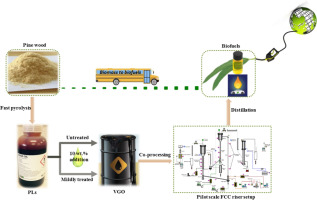当前位置:
X-MOL 学术
›
Fuel Process. Technol.
›
论文详情
Our official English website, www.x-mol.net, welcomes your feedback! (Note: you will need to create a separate account there.)
Co-processing of crude and hydrotreated pyrolysis liquids and VGO in a pilot scale FCC riser setup
Fuel Processing Technology ( IF 7.5 ) Pub Date : 2018-12-01 , DOI: 10.1016/j.fuproc.2018.09.023 Chenxi Wang , Robbie Venderbosch , Yunming Fang
Fuel Processing Technology ( IF 7.5 ) Pub Date : 2018-12-01 , DOI: 10.1016/j.fuproc.2018.09.023 Chenxi Wang , Robbie Venderbosch , Yunming Fang

|
Abstract Untreated and mildly hydrotreated pyrolysis derived liquids are evaluated in FCC processing by co-feeding with vacuum gas oil (‘VGO’). Pyrolysis liquids (PLs) applied are from the Empyro plant in the Netherlands. The treated PLs are produced by BTG employing novel bimetallic Ni-based catalyst (Picula), at 200 bar hydrogen pressure and two temperatures, 120 °C and 225 °C. A pilot scale riser setup (riser: I.D. = 7 mm, length = 9 m; combustor: I.D. = 78 mm) is employed to process the liquids with VGO. The riser is operated at a riser outlet temperature of 525 °C, atmospheric pressures and Cat-to-Oil (‘C/O’) ratio ranging from 5 to 8. Co-processing ratios are kept constant at 10:90 (PLs:VGO). The most relevant observations compared to processing of only VGO are: – At all C/O ratios, the conversion observed in the co-processing tests is higher. – The yield of coke, dry gas and LPG in all co-processing tests is lower. – At such high substitution levels co-processing crude PL shows a decrease in the gasoline yield and slightly higher yield of LCO and bottoms. – The treated bio-liquids yield similar levels of gasoline and LCO. During crude PL co-processing CO and CO2 are noted, and a decrease in H2 yield is found compared to pure VGO. Renewable carbon is observed in the liquids obtained in both co-processing crude PL and stable pyrolysis oil (SPO), while the mild hydrotreating steps are more effective.
中文翻译:

在中试规模的 FCC 立管装置中协同处理原油和加氢处理热解液和 VGO
摘要 未经处理和轻度加氢处理的热解衍生液体在 FCC 加工中通过与真空瓦斯油 ('VGO') 共同进料进行评估。应用的热解液 (PL) 来自荷兰的 Empyro 工厂。经处理的 PL 由 BTG 使用新型双金属镍基催化剂 (Picula) 在 200 bar 氢气压力和两个温度(120°C 和 225°C)下生产。采用中试规模的立管装置(立管:ID = 7 mm,长度 = 9 m;燃烧器:ID = 78 mm)用 VGO 处理液体。立管在 525 °C 的立管出口温度、大气压和 5 到 8 的催化剂油 ('C/O') 比范围内运行。协同处理比保持恒定在 10:90 (PLs: VGO)。与仅处理 VGO 相比,最相关的观察结果是: – 在所有 C/O 比率下,在协同处理测试中观察到的转化率更高。– 在所有协同处理测试中,焦炭、干气和液化石油气的产量较低。– 在如此高的替代水平下,协同处理原油 PL 会导致汽油收率下降,而 LCO 和残渣的收率略高。– 处理过的生物液体产生相似水平的汽油和 LCO。在粗PL协同处理CO和CO2过程中,发现与纯VGO相比,H2产率有所降低。在协同处理原油 PL 和稳定热解油 (SPO) 中获得的液体中观察到可再生碳,而温和的加氢处理步骤更有效。– 处理过的生物液体产生相似水平的汽油和 LCO。在粗PL协同处理CO和CO2过程中,发现与纯VGO相比,H2产率有所降低。在协同处理原油 PL 和稳定热解油 (SPO) 中获得的液体中观察到可再生碳,而温和的加氢处理步骤更有效。– 处理过的生物液体产生相似水平的汽油和 LCO。在粗PL协同处理CO和CO2过程中,发现与纯VGO相比,H2产率有所降低。在协同处理原油 PL 和稳定热解油 (SPO) 中获得的液体中观察到可再生碳,而温和的加氢处理步骤更有效。
更新日期:2018-12-01
中文翻译:

在中试规模的 FCC 立管装置中协同处理原油和加氢处理热解液和 VGO
摘要 未经处理和轻度加氢处理的热解衍生液体在 FCC 加工中通过与真空瓦斯油 ('VGO') 共同进料进行评估。应用的热解液 (PL) 来自荷兰的 Empyro 工厂。经处理的 PL 由 BTG 使用新型双金属镍基催化剂 (Picula) 在 200 bar 氢气压力和两个温度(120°C 和 225°C)下生产。采用中试规模的立管装置(立管:ID = 7 mm,长度 = 9 m;燃烧器:ID = 78 mm)用 VGO 处理液体。立管在 525 °C 的立管出口温度、大气压和 5 到 8 的催化剂油 ('C/O') 比范围内运行。协同处理比保持恒定在 10:90 (PLs: VGO)。与仅处理 VGO 相比,最相关的观察结果是: – 在所有 C/O 比率下,在协同处理测试中观察到的转化率更高。– 在所有协同处理测试中,焦炭、干气和液化石油气的产量较低。– 在如此高的替代水平下,协同处理原油 PL 会导致汽油收率下降,而 LCO 和残渣的收率略高。– 处理过的生物液体产生相似水平的汽油和 LCO。在粗PL协同处理CO和CO2过程中,发现与纯VGO相比,H2产率有所降低。在协同处理原油 PL 和稳定热解油 (SPO) 中获得的液体中观察到可再生碳,而温和的加氢处理步骤更有效。– 处理过的生物液体产生相似水平的汽油和 LCO。在粗PL协同处理CO和CO2过程中,发现与纯VGO相比,H2产率有所降低。在协同处理原油 PL 和稳定热解油 (SPO) 中获得的液体中观察到可再生碳,而温和的加氢处理步骤更有效。– 处理过的生物液体产生相似水平的汽油和 LCO。在粗PL协同处理CO和CO2过程中,发现与纯VGO相比,H2产率有所降低。在协同处理原油 PL 和稳定热解油 (SPO) 中获得的液体中观察到可再生碳,而温和的加氢处理步骤更有效。



























 京公网安备 11010802027423号
京公网安备 11010802027423号